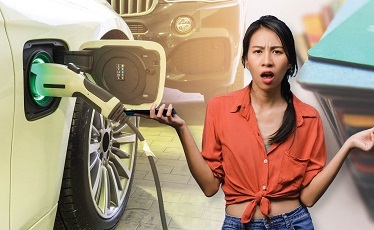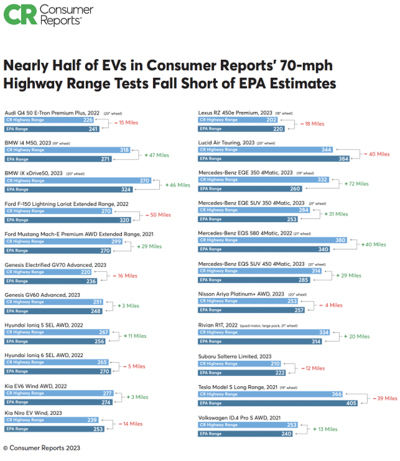Consumer Reports: Nearly Half of EVs in Our Highway-Only Range Test Fell Short of Their EPA Estimates
 |
The EPA’s EV range estimates listed on window stickers and at fueleconomy.gov do not indicate separate city and highway ranges, as they do with conventional cars and hybrids. To find out how much range EV models actually get in highway driving conditions, CR put 22 of the most popular new EVs through a new highway-speed range test, driving fully-charged vehicles at a steady speed of 70 mph and only stopping when each vehicle’s battery was completely depleted and the vehicle was inoperable. The results show that the EPA estimate doesn’t always accurately reflect the range that drivers can expect in highway driving, where every mile matters.
“Most drivers travel relatively short distances on a daily basis and are highly unlikely to reach the range limits of most new EVs. But long road trips are a different story. We feel that consumers should have an idea of how far EVs can travel on a long highway-centric journey,” said Alex Knizek, CR’s manager of auto testing and insights. “Range is much more important when you’re far from home and away from reliable charging.”
Of the 22 EVs tested by CR so far, nearly half fall short of their EPA-estimated ranges when driven at highway speeds. CR’s engineers found the biggest difference in range with the Ford F-150 Lightning pickup truck: Its battery ran out after just 270 miles—a 50-mile difference from the EPA estimate.
On the other hand, some vehicles from BMW and Mercedes-Benz beat their EPA-estimated ranges by more than 40 miles, including the BMW iX and BMW i4, and the Mercedes-Benz EQE 350 4MATIC.
Going forward, CR will continue to evaluate highway range for every EV it tests. CR is also asking the EPA to add a highway-speed range test, as organizations including Car and Driver and SAE International, have done.
CR Updates EV Charging and Performance Scores
In addition to the new highway range test, CR has added new ratings and updated its existing tests to better reflect how EVs perform in real-world driving.
“This new information allows shoppers to compare the unique characteristics of EVs and what it’s like to live with them every day,” says Jake Fisher, CR’s senior director of automotive testing. “Since we live with the EVs we purchase for our testing program just like ordinary consumers, we know what it’s like to plug in our EVs every night or at public chargers on a road trip.”
CR now evaluates EVs for charging performance for both level 2 (AC) and level 3 (DC) fast charging under ideal conditions, giving higher scores to vehicles that charge quickly but are also more energy-efficient, resulting in more miles of range per charge. Higher marks will also be given to models that are easy to plug in and come with built-in features that make charging easier, such as navigation routing designed to minimize time spent finding chargers and plugging in, and full-featured smartphone apps.
Additionally, CR is now scoring the ease of one-pedal driving, in which the driver can speed up or slow down just by modulating the accelerator pedal, as part of an EV’s Transmission score. CR also reduced the weight of how much acceleration matters in its Road Test score, since most EVs offer blazing fast acceleration that’s impractical for public roads.
CR has also revised EV model pages on CR.org to reveal information such as each vehicle’s charging speed for a variety of chargers, battery size, location of the charging port, and other specs and ratings that will help make comparing EVs side-by-side easier for consumers.
Full details on CR’s EV highway range test results and testing protocols, and changes to CR EV performance testing can found online at CR.org.
CR buys all of its test cars anonymously from dealers and does not accept free samples from automakers for any of its ratings or evaluations. CR’s testers drive a total of 500,000 miles annually in the vehicles it evaluates, which is the equivalent of circling the Earth twenty times.
About Consumer Reports
Founded in 1936, CR has a mission to create a fair and just marketplace for all. Widely known for our rigorous research and testing of products and services, we also survey millions of consumers each year, report extensively on marketplace issues, and advocate for consumer rights and protections around safety as well as digital rights, financial fairness, and sustainability. CR is independent and nonprofit.
© 2023 Consumer Reports. The material above is intended for legitimate news entities only; it may not be used for advertising or promotional purposes. Consumer Reports® is an expert, independent, nonprofit organization whose mission is to work side by side with consumers to create a fairer, safer, and healthier world. We accept no advertising and pay for all the products we test. We are not beholden to any commercial interest. Our income is derived from the sale of Consumer Reports® magazine, ConsumerReports.org® and our other publications and information products, services, fees, and noncommercial contributions and grants. Our Ratings and reports are intended solely for the use of our readers. Neither the Ratings nor the reports may be used in advertising or for any other commercial purpose without our prior written permission. Consumer Reports will take all steps open to it to prevent unauthorized commercial use of its content and trademarks.



